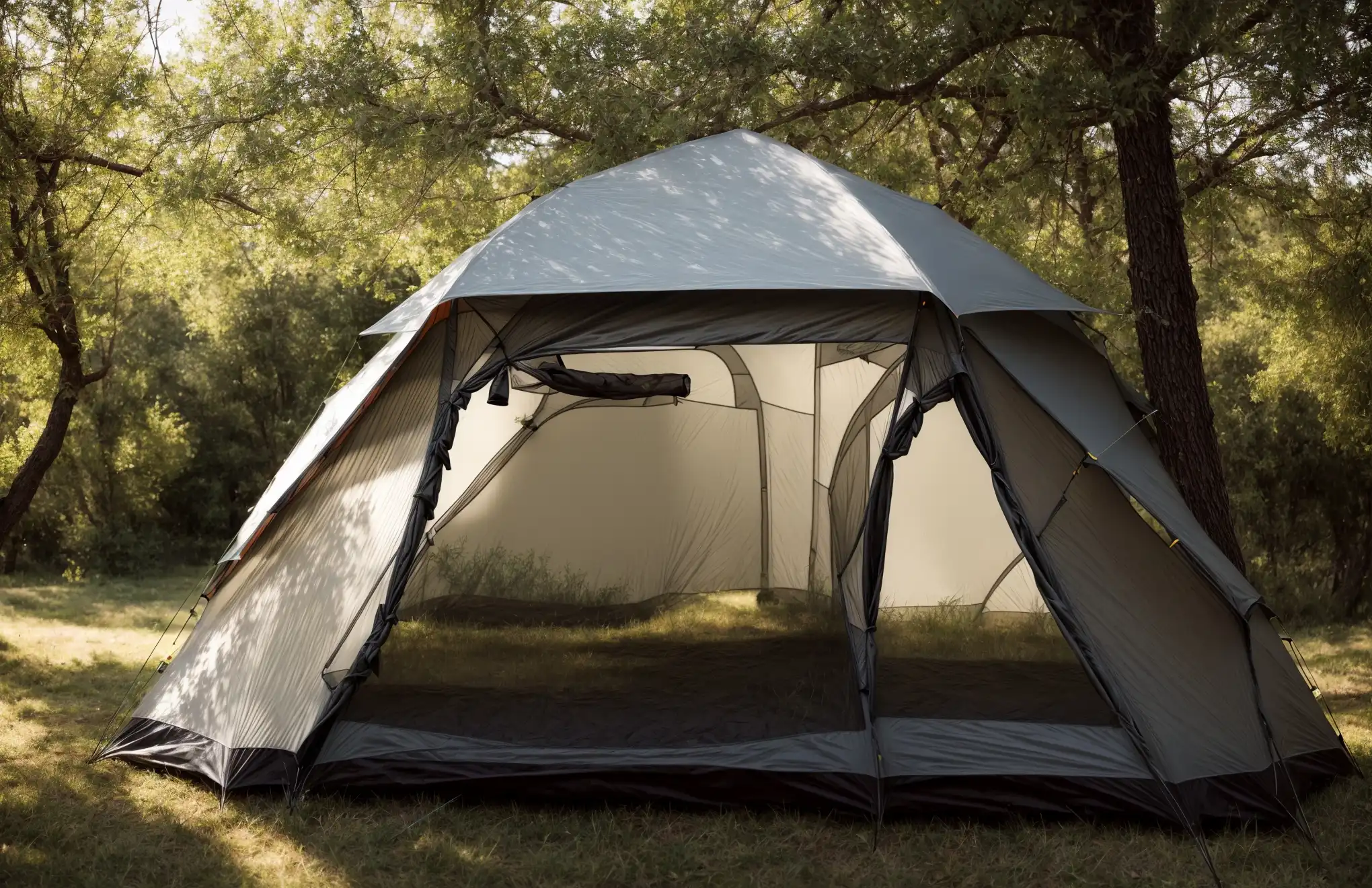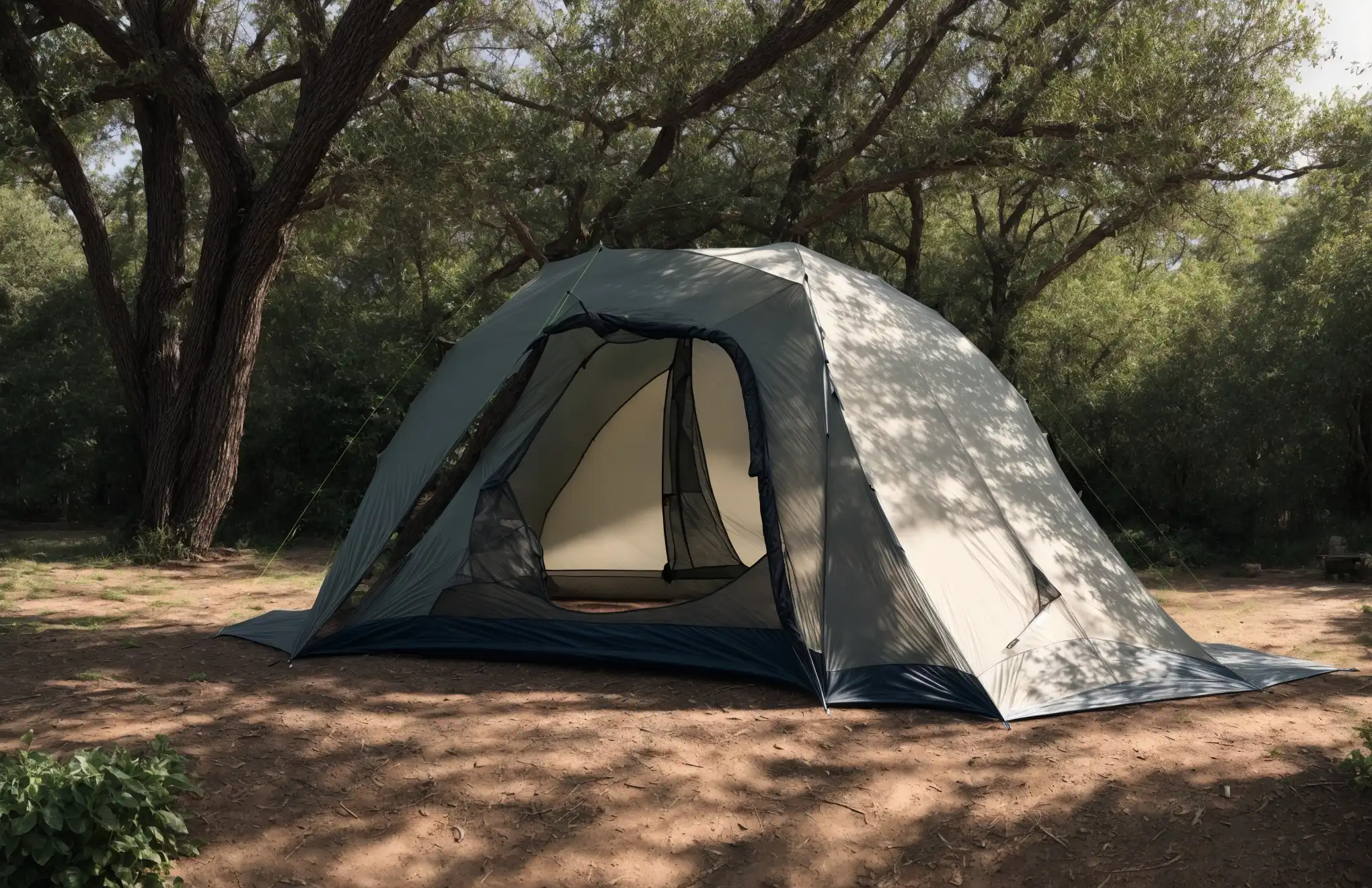To cool a tent without electricity, use reflective tarps, natural ventilation, and ice packs. Position the tent in the shade, allowing natural airflow, and consider thermal-efficient bedding.
Camping in the great outdoors can be an exhilarating experience, but high temperatures might turn your tent into a sauna. Ventilation is key; strategically place your tent to maximize cross breezes and use the natural environment to your advantage. Opting for a location with ample shade during peak sun hours will greatly reduce the heat build-up.
The use of reflective tarps reflects the sun’s rays away from your shelter, lowering the temperature inside without the need for electric gadgets. Incorporating ice packs or cool water containers inside the tent creates a cooler microclimate through the melting process. Additionally, choosing specially designed sleeping gear with thermal regulation helps maintain a comfortable sleeping area. By adopting these techniques, campers can ensure their tent remains a refreshing retreat from the heat, even off the grid.
About Tent Cooling Challenges
As the mercury rises and the swelter of summer sets in, campers and outdoor enthusiasts face a formidable opponent: the relentless heat of a sun-baked tent. Cooling a tent effectively can be the difference between a restful retreat and a sweltering nightmare. The quest for a comfortable tent temperature beckons innovation and resourcefulness, particularly when electricity is not an option. Let us delve into the world of cooling tents without relying on powered gadgets, exploring not only the necessity but also the creativity such a challenge inspires.
Understanding The Need For Cooling Tents
Tents, by design, are meant to provide shelter. Yet, they often fall short in offering respite from the heat, transforming into saunas under the sun. The need for cooling tents lies in ensuring that the sanctuary of an outdoor adventure remains comfortable and safe. With scorching temperatures posing risks like heatstroke and dehydration, finding efficient ways to cool down becomes imperative.
The Problems With Relying on Electricity
Traditional methods of tent cooling typically involve electric fans or air conditioners, yet these solutions often prove impractical in the great outdoors. The reliance on electricity poses multiple challenges – access to power sources is scarce, generators are cumbersome, and such dependence is not eco-friendly. Moreover, in the serene embrace of nature, the hum of electrical devices disrupts the peaceful ambiance that many seek.
Importance of Sustainable and Accessible Solutions
What then, caters to the modern camper’s cooling needs without the umbilical cord of electricity? Sustainable and accessible solutions rise to the forefront, offering environmentally considerate options that can be utilized by anyone, anywhere. These solutions not only alleviate the discomfort of heat but do so by harmonizing with the natural environment, preserving the tranquility and purity of outdoor experiences.
Natural and Passive Cooling Strategies
Embarking on an outdoor adventure doesn’t have to mean enduring sweltering heat inside your tent. With the right strategies, keeping your tent cool without relying on electricity is entirely possible. Let’s explore some natural and passive cooling techniques that can transform your camping experience, making it more comfortable and enjoyable.

Choosing the Optimal Location For Airflow and Shade
The first step towards a cooler tent begins with the selection of the campsite. Seek out areas that are naturally conducive to cooler conditions. A strategic spot would be at a higher elevation where the air is typically cooler and breezier. Also, consider the following for the optimal site:
- Proximity to a body of water – Breezes from lakes or streams can offer natural cooling.
- Natural shade – Look for trees or rock formations that can shield your tent during the hottest parts of the day.
- Orientation – Positioning your tent with the entrance facing the wind invites cooler air inside.
Maximizing Ventilation With Tent Design and Setup
Ventilation plays a critical role in lowering a tent’s temperature. The design of your tent can greatly affect its airflow capabilities:
- Select a tent with large mesh panels or windows to promote cross ventilation.
- Opt for tents with multiple openings at different heights to create a convection current of cool air.
When setting up your tent, leave all vents unobstructed for maximum airflow. Elevate the rainfly slightly to allow air to circulate between the fly and the tent body, reducing condensation and stagnation of hot air.
The Role of Thermal Absorbents and Reflective Materials
Reflective materials and thermal absorbents can effectively shield your tent from absorbing excessive heat:
- Use a reflective tarp or space blanket strategically above your tent to reflect the sun’s rays away from your shelter.
- Place absorbent materials like wet towels or special cooling crystals around your tent to soak up warmth and aid in evaporative cooling.
Insulation Techniques To Maintain Lower Temperatures
Insulating your tent might seem counterintuitive for cooling, but proper insulation can keep the interior of a tent significantly cooler. Employing the following techniques can ensure that your tent remains an oasis of calm:
- Use a reflective emergency blanket as ground cover inside the tent to reflect heat back to the ground.
- Utilize specialized tent footprint that provides a layer of insulation between the ground and your tent floor.
- Insulate the top of your tent with lightweight, breathable fabrics to keep heat at bay without restricting airflow.
Active Non-electric Cooling Methods
Escaping to the great outdoors doesn’t have to mean sweltering in a stifling tent. There are several active non-electric cooling methods that can keep your tent cool and comfortable even during the peak of summer. Let’s explore practical techniques that provide relief from the heat without relying on a traditional power source.
Utilizing Manually-operated Fans
Manually-operated fans offer a simple, efficient way to circulate air within your tent. The slight breeze they generate can significantly reduce the perceived temperature, creating a more pleasant environment for lounging or sleeping.
- Handheld fans: Portable and lightweight, these fans are perfect for personal cooling.
- Foot-powered air pumps: Originally designed for inflating air mattresses, they can double as large-volume air movers to keep air fresh in a tent.
Ice-based Cooling Solutions
Harnessing the chilling power of ice is an excellent way to bring down the temperature. Here’s how:
- Ice chest: Place a block of ice in a small container and position it in front of a fan for a makeshift air conditioner.
- DIY ice packs: Freeze water bottles and place them throughout your tent to serve as cool spots.
Battery-operated Or Solar-powered Devices
Battery or solar power can be a game changer in off-grid tent cooling. These devices can offer extended relief:
- Portable battery-operated fans: These come in varying sizes and can last through the night on a single charge.
- Solar-powered fans and coolers: They leverage sunlight to keep the air moving or actively cool the interior of your tent.
Evaporative Cooling With Wet Cloths and Misting
Evaporation absorbs heat, thus cooling the surrounding air. Implementing this principle, drape wet cloths over your tent’s entrance or use a hand-held mister to spray a fine mist inside for an instant drop in temperature.
| Method | How It Works | Effectiveness |
|---|---|---|
| Wet cloths | Moisten a towel or shirt and hang it in a shaded area or in front of a fan. | Cools air as water evaporates from the cloth. |
| Misting | Use a spray bottle to create a mist in the tent’s air. | Keeps skin cool and lowers air temperature locally. |
Behavioral and Scheduling Adaptations
Keeping your tent cool without relying on electric gadgets involves more than just equipment; it’s also about adjusting your daily patterns and behaviors. By aligning your activities with the natural rhythms of the environment, you can significantly increase your comfort levels in the great outdoors. Let’s explore how altering your schedule and regulating activities can lead to a cooler camping experience.
Adjusting Activity Levels During the Hottest Periods
To escape the sweltering heat, it’s crucial to plan your day so that you minimize exertion during the hottest parts of the day, typically from late morning to mid-afternoon. Rest or engage in low-energy activities during these hours to prevent overheating.
Using Natural Water Sources For Cooling
Proximity to a lake, river, or stream can be a game-changer. Dipping into these natural water sources provides an instant drop in body temperature, while damp cloths placed on the skin offer relief from the heat as they evaporate.
Scheduling Activities For Cooler Times of the Day
Early mornings and late evenings are your allies in the battle against heat. Plan hikes, fishing, or any physically demanding task during these times. You’ll enjoy the outdoors in a much more pleasant, cooler environment.
Proper Hydration and Attire to Help Body Thermoregulation
Never underestimate the power of staying hydrated and choosing the right clothing to aid body cooling. Wear light-colored, loose-fitting clothes that reflect sunlight. A wide-brimmed hat is also useful. Drink water regularly, even before you feel thirsty, to keep your body’s cooling system running smoothly.
To know more: How Big is 4 Person Tent
Conclusion
Wrapping up, chilling a tent sans electricity is a breeze with these tips. Embrace natural shade, reflective tarps, and ground insulation. Stay hydrated and plan activities for cooler times. Your next camping adventure can be both eco-friendly and comfortable without relying on electronic gadgets.
Expand your camping knowledge with each visit to our Learning section at Outdoor Awaits. There’s always something new! Happy camping and stay cool!
Sukhen is a passionate blogger and traveler who visited many historical places in Bangladesh, Myanmar, India, and Thailand. He’s an avid camper, so he shares his knowledge of camping and wildlife with his readers. He also helps readers plan their own camping trips. To know more, stay connected with Outdoor Awaits.

